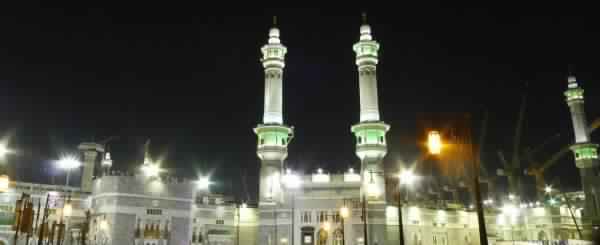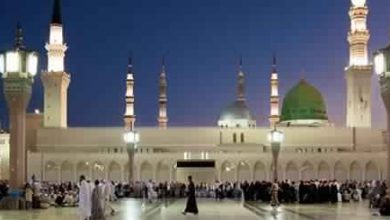HAJJ DIARIES PART 1

I performed my hajj last year, Alhamdulillah, and managed to post some blogs here – http://hadithoftheday.com/the-hajj-diaries/. The whole experience passed by like a blur, it was at whirlwind speed and I’m still getting my head around it!
Now a year later, I’m watching the live footage of hajj being broadcast on television. It brings back a flood of memories, and makes me realize the sheer enormity of scale involved, and what a momentous event it was in my life.
The issue I’m still absorbing is that Allah actually allowed me to perform my hajj! I thought that this was a right reserved for the super-pious – certainly I never thought that people who led ordinary lives like me would ever be worthy of Allah’s invitation.
Each person’s hajj is unique, and no two experiences will ever compare. The different experiences in hajj are not just a matter of variations in the travel agent and accommodation, but it is a unique personal journey for each of us. Each has different stories to tell, and each has different personal battles to conquer before and during the journey.
Madinah
As a prelude to the actual rituals, we started our journey in Madinah, which in my view, is a gentler environment compared to Mekah. Although not obligatory, it is a sunnah to also pay a visit to Masjid Al Nabawi in Madinah when performing umrah and hajj, not least because of the numerous blessings of that holy city and masjid. A prayer in Masjid Al Nabawi is worth 1000 of that in other mosques, apart from Masjid Al Haram.
Madinah is where Rasulullah SAW established the first centre of Islam after his migration from Mekah, and this is where he passed away and is buried. There is a spot called Rawdhat ul Jannah of which Rasulullah SAW said “one of the gardens of Jannah lies between my house and my pulpit.” Imagine being able to perform salat on this spot!
Two of the most famous Companions are buried beside the Prophet SAW: his best friend Abu Bakr as Siddiq RA; and a man who set out to the Prophet SAW with the intention to kill him but instead embraced Islam and became one of its best people – Umar Al Khattab RA. It is possible to give salutations to the Prophet SAW in close proximity to his grave, when access to the Rawdhat is permitted. Visiting the Rawdhat was an intensely personal and inspirational experience – of course, the intention was to make “salawat” to the Prophet SAW and to give greetings to his Companions, not to pray to them.
When Rasulullah SAW passed away, there were roughly 120,000 Companions, yet only a few of them (less than 10,000) are buried in Madinah. The rest, including the great names of Islam such as Bilal RA and Khalid Al Walid RA, uprooted themselves from Arabia and spent their lives spreading Islam in foreign lands. How many of us are now Muslim through their indirect efforts which were initiated centuries ago? Masha Allah, what a legacy these people left behind. May Allah bless all of them and give us the qualities they had. Ameen.
Mekah – Facing the Ka’bah
When we headed for Mekah for the official rites of the hajj and umrah, what struck me was how barren and desolate the landscape was. Mount Uhud at best, is a rugged and harsh environment. Yet, Rasulullah SAW and his Companions RA travelled this hostile terrain, some of them on foot, and some of them barefoot.
It does not even compare to our experience, riding on a coach with air conditioning and tinted windows – while many may complain of hardship during hajj, not even our worst experiences can compare to the hardship faced by the Prophet SAW and the Companions.
The atmosphere was solemn, but also charged, where the passengers, all decked in ihram (simple ceremonial clothes prescribed for performing hajj or umrah) chanted the famous call of “Labaikallahumma Labaik” (Here I am, O Allah, in response to your call. Here I am).
The central focus of Mekah is the Ka’bah. Physically, it is a modest structure, but the spiritual power emanating from it can reduce grown men to tears. Perhaps (and this is a personal opinion only) the effect can be felt in direct proportion to one’s faith.
As a rebellious teenager, when I first saw the Ka’bah, I was initially disappointed. It was so tiny! But now, when I see it, I literally go weak in the knees. As an arrogant teenager, the Ka’bah seemed so diminutive, and now, having experienced some hard knocks in life, the Ka’bah to me is truly the most magnificent structure in the world. It is not just the building, but also the layers of history it represents.
The Ka’bah is the house of Allah on this world, and to be in its proximity was humbling and inspiring at the same time. I spent many hours greedily gazing upon its beauty, praying, and supplicating.
Those moments of contemplation and awe often left me in tears. Me? I was always someone who thought that religion was a peripheral duty, and even a burden, until Allah guided me to understand better. And now, even with the weight of my sins and wrongs, through the fog of ignorance and various misunderstandings I had about Islam most of my life, Allah had brought me here. Yes, it was crowded and congested, but worth more than any red carpet invitation on earth!
The umrah rite is simple enough – once seven rounds of tawaf (in a counter-clockwise direction around the Ka’bah) were completed, the umrah rite is perfected by the sa’iee, a walk between the hills of Safa and Marwa which also goes back and forth seven times.
The only challenge during the peak season was the swell of people, where sometimes things can come to a standstill because of the sheer numbers. The area around the Ka’bah is now paved with marble and the stretch between Safa and Marwah is now fully covered and air conditioned – a far cry from the searing sands of 1400 years ago where people had to perform this rite under the blazing sun.
No ritual of hajj or umrah can be complete without imitating the footsteps of a woman. In performing the sai’ee, all Muslims are imitating the footsteps of Hajr, the wife of Ibrahim AS, when she was looking for water in the desert for her dying son Ismail AS. It was also at this time that the zam-zam well was born, as an answer by Allah to the prayers of His devoted slave – a simple female servant girl who is now so elevated in Islam that we still walk in her footsteps to complete our hajj and umrah rituals.
The sai’ee is a reminder that Allah is always there to answer the prayers of His believing slaves, no matter how impossible or desperate the situation.
Mina
The actual hajj rituals which differentiate them from umrah started when we left Mekah to spend a few nights in Mina. When we left for Mina, we were in full ihram again. For men it was two pieces of unsewn white cloth, as a sign of equality and also as a prelude to what will be worn to the grave. Regardless of race, wealth or ancestry, we were all equal before Allah. In death, and in Mina, there will be no fancy accommodation, creature comforts or dunia.
The days that followed were to be the pinnacle of the hajj rituals. My question to myself was whether I would come out the other side, more aware of my own bad manners and other shortcomings, with a strengthened faith in Allah. Frankly, most of my previous life was a mess and I was still far from being a good person.
Yet, I realized with gratitude, that with all my terrible mistakes and shortcomings, Allah in His mercy and compassion still brought me there. He was still giving me a chance to clean up. Ya Rahman, ya Ghafur. What else do we need before we die other than Allah’s forgiveness? Even now, I am humbled at how Allah did not close the door of forgiveness, nor make me blind to His message.
We were in Mina camp for three days. Things were at their bare basics – we slept on the floor, shared 30 to a tent and had to use communal bathrooms with extremely basic facilities. Men and women were placed in separate quarters. The food was also simple – it was good enough to provide sustenance, and no more.
There is no specific ritual for Mina, the time was for seclusion from the comforts of dunia, to reflect on oneself and to go back to the root of our faith. This was my biggest challenge, to live with contentment amidst the heat and discomfort, to mentally block out all the clamour, laughter and chit-chat of the surroundings and to establish a relationship with Allah.
Mina was to be a time of isolation and focus, and I was told that if I could not learn to focus on Allah at such a sacred time and place, then what chance would I have to succeed in the real world where distractions would be multiplied by hundreds?
It was tough at first but I learnt a few valuable lessons about who I really was and the extent of my spiritual deficiencies.
In particular, I learnt a valuable lesson about having unconditional faith in Allah. I was struck with a really impossible calamity – one I would have willingly given everything I owned in this world to solve, and which put my ability to complete my hajj in utter jeopardy. I worried about my situation and made du’a repeatedly, but to no avail, because at the back of my mind, I knew the situation was impossible.
It was after a couple of days, with time running out, when I had become as desperate as a drowning person that I realised that I harboured doubts – I was using intellect instead of faith when praying to Allah the Almighty. I was looking at the hopelessness of the situation instead of focusing on Allah’s infinite power to change any condition. My tongue professed absolute submission but my heart held back. I still had uncertainty!
At that moment I understood the true power of surrender – to trust only Allah for help and not listen to my fears or doubts. To trust that Allah, the Creator of the Universe, was listening to me, and all I needed was to prove my unconditional faith to Him before He replied. At that point of total submission, my du’a immediately crystallised into reality, and the impossible became possible.
This was the most important lesson I learnt during hajj. Allah is the absolute Owner of all conditions, and it is not my money or intellect that solves problems, it is Allah and none else. Surrendering to that is so beautiful and humbling!
Conclusion in Hajj Diaries Part 2.




